Have you ever wondered if the bamboo growing in your garden or a nearby park is edible? Many people see bamboo as just panda food or a building material. They miss out on a delicious and sustainable food source, often because they are unsure which types are safe to eat and how to prepare them.
Yes, many varieties of bamboo are edible, but they must be cooked properly first. Some of the most popular and safest species for consumption include Moso bamboo (Phyllostachys edulis), Sweet bamboo (Dendrocalamus latiflorus), and Giant Timber bamboo (Bambusa oldhamii). Raw bamboo shoots contain natural toxins that are easily removed by boiling, which makes them tender, delicious, and completely safe to enjoy in a variety of dishes.
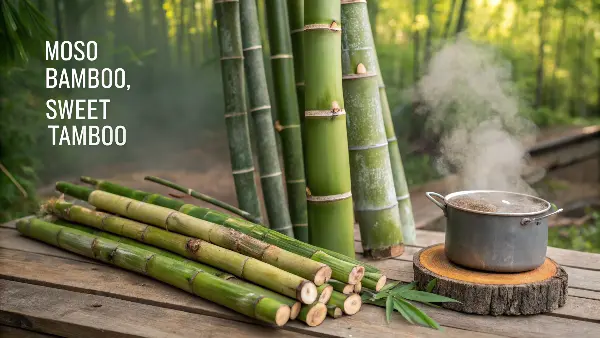
It’s amazing how one plant can offer so much. Here at Ecosourcecn, our work revolves around sustainable materials, and bamboo is one of our heroes. We use it to create eco-friendly tableware and packaging solutions for businesses around the world. But my fascination with bamboo goes beyond products. It extends to its role as a food source, a journey that connects sustainability directly to our plates. This guide is based on my experiences and research, designed to help you confidently explore the world of edible bamboo.
Let’s dive into the specifics, so you can tell the tasty shoots from the rest and prepare them like a pro.
How Can You Tell Edible Bamboo Apart From Other Types?
Foraging for wild food feels wonderfully primal, but when it comes to bamboo, it can be a bit scary. You want to connect with nature’s pantry, not make a mistake. Choosing the wrong shoot could lead to a tough, bitter meal, or worse, turn you off from this amazing food forever. I’ll show you the key signs to look for.
The most reliable way to identify edible bamboo is to first identify the parent plant, as shoots from known edible species are safe. Look for young, conical shoots emerging near the base of the clump. Edible shoots are typically larger, fleshy, and covered in smooth sheaths, often without too much dark hair. When in doubt, avoid any shoot that looks overly thin, woody, or comes from an unidentifiable bamboo species.
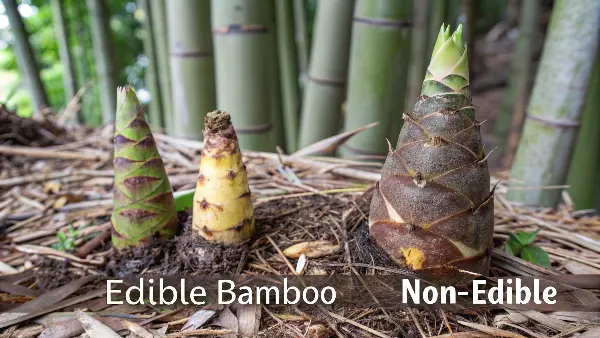
When I first started learning about edible bamboo on a sourcing trip in Zhejiang, a farmer gave me the best piece of advice: "Know the mother before you take the child." He was telling me to focus on the parent plant. Some bamboo species are mainly grown for timber or ornamental purposes, and their shoots can be incredibly bitter. Others are prized for their culinary qualities. Learning to spot the parent culms (the main stalks) of edible varieties like Moso or Bambusa is the first and most important step. It takes practice, but once you can recognize a few key species, you’ll feel much more confident.
Key Identification Features
The key is to use a combination of clues. Never rely on just one feature. Look at the whole picture, from the mature plant down to the young shoot at your feet.
-
Inspect the Parent Plant
If you can, identify the species of the bamboo clump. For example, Moso bamboo (Phyllostachys edulis) is a giant, with thick, tall culms that have a distinctive powdery look when young. Giant Timber bamboo (Bambusa oldhamii) is a clumping bamboo with large, straight culms often used as a privacy screen. Knowing you’re starting with a known edible variety is 90% of the battle.
-
Examine the Shoot
Edible shoots are harvested when they are young and tender. They should feel solid and heavy for their size. Look at the sheaths, the paper-like layers protecting the shoot. On many edible types, these are relatively smooth. Some bitterness is normal, but intensely bitter shoots often come from less desirable varieties.
Quick Comparison Guide
This table can help you make a quick assessment in the field.
| Feature | Edible Shoot Clues | Inedible/Bitter Shoot Clues |
|---|---|---|
| Size & Shape | Typically thick, conical, and fleshy. Heavy for its size. | Often very thin, fibrous, and lanky. |
| Parent Plant | Belongs to a known edible species (e.g., Moso, Bambusa). | From an unknown or purely ornamental species. |
| Sheaths (outer layers) | Relatively smooth, may have fine hairs. Easy to peel. | Can be covered in dense, dark, irritating hairs. |
| Feel | Firm and solid. Breaks with a crisp snap. | Feels woody, tough, or hollow. Bends instead of snaps. |
| Local Knowledge | Used as a food source by locals or sold in markets. | Ignored by local foragers and animals. |
If you have any uncertainty, the safest choice is to leave it. Sourcing shoots from a trusted farmer’s market or an Asian grocery store is a great way to start until you can confidently identify them yourself.
What Are the Most Popular Edible Bamboo Species Around the World?
You’re ready to try bamboo, but a trip to an international market or even a look online reveals a confusing number of choices. You hear about "winter shoots" and "spring shoots," Moso and Bambusa. Choosing the right one feels like a gamble when you don’t know which will be sweet and crisp versus bland or tough. Let’s break down the most popular culinary stars.
Globally, the most famous edible species is Moso bamboo (Phyllostachys edulis), which dominates the market and is known for its crisp texture. In Southeast Asia and Taiwan, Sweet bamboo (Dendrocalamus latiflorus) is a favorite for its lower bitterness and tender flesh. Other important varieties include Giant Timber bamboo (Bambusa oldhamii) and a ‘workhorse’ species, Bambusa bambos, each valued for its unique flavor and use.
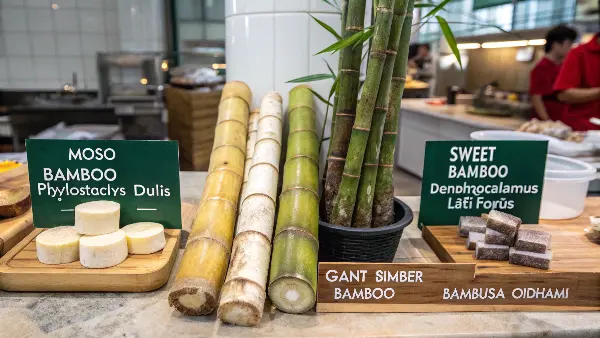
Different cultures have cultivated their favorite bamboo species for centuries. It’s just like how we have hundreds of apple varieties, from Granny Smith for pies to Honeycrisp for snacking. Each bamboo species offers a slightly different taste, texture, and culinary application. Understanding the main players helps you know what to buy. For instance, the large, robust Moso shoots are perfect for slicing and stir-frying, while more tender varieties might be better for soups and salads. As a supplier of bamboo products, I find this diversity fascinating—it shows the plant’s incredible versatility.
A Tour of Culinary Bamboo
Let’s meet some of the most common species you’ll encounter. They each have a personality of their own.
-
Moso Bamboo (Phyllostachys edulis)
This is the celebrity of the bamboo world. Native to China and Taiwan, it produces very large shoots. "Winter shoots" are harvested before they emerge from the soil and are prized for their extreme tenderness and subtle flavor. "Spring shoots" are larger, more common, and have a wonderfully crisp texture. Most canned bamboo shoots you find in supermarkets are from Moso.
-
Sweet Bamboo (Dendrocalamus latiflorus)
As the name suggests, this species is known for having less of the acrid, bitter taste found in other raw shoots. It’s extremely popular in Taiwan and Southeast Asia. The shoots are large, fleshy, and cook up to be very tender. They are fantastic when boiled and served simply with a dipping sauce or added to complex curries.
-
Giant Timber Bamboo (Bambusa oldhamii)
This is a success story for bamboo lovers in Western countries. It was introduced as a fast-growing ornamental privacy screen but happens to produce delicious, high-quality shoots. They have a mild, sweet flavor and are not bitter. This is a great choice for home gardeners who want a plant that is both beautiful and productive.
Global Favorites at a Glance
This table sums up the key players and their best uses.
| Species Name | Common Name | Primary Region | Flavor Profile | Best For |
|---|---|---|---|---|
| Phyllostachys edulis | Moso Bamboo | East Asia | Crisp, mild, slightly sweet | Stir-fries, braising, canning |
| Dendrocalamus latiflorus | Sweet Bamboo | Southeast Asia, Taiwan | Tender, low bitterness | Soups, salads, curries |
| Bambusa oldhamii | Giant Timber Bamboo | Worldwide (subtropical) | Mild, sweet, not bitter | Roasting, grilling, home gardens |
| Bambusa bambos | Thorny Bamboo | South & SE Asia | Firm, slightly bitter | Pickling, shredded in dishes |
| Phyllostachys nigra | Black Bamboo | China | Tender, delicate | Steaming, salads (ornamental too) |
When you’re shopping, don’t be afraid to ask the seller what kind of shoot they have and what they recommend it for. They often have the best, generationally-tested advice.
Why Do Bamboo Shoots Need to Be Cooked Before Eating?
You’ve found the perfect bamboo shoots, but then you remember hearing a warning: they might be toxic raw. This alarming idea can make you hesitate, questioning if it’s worth the risk. This fear and confusion prevent many people from enjoying one of Asia’s most beloved vegetables. Let me clarify the science—it’s simple and completely manageable.
Raw bamboo shoots contain compounds called cyanogenic glycosides. When the plant tissue is crushed, these compounds can release small amounts of cyanide. This is a natural defense mechanism for the plant. The good news is that these toxins are completely destroyed by heat. Boiling fresh bamboo shoots for at least 20-30 minutes neutralizes the compounds, making them perfectly safe and delicious to eat.
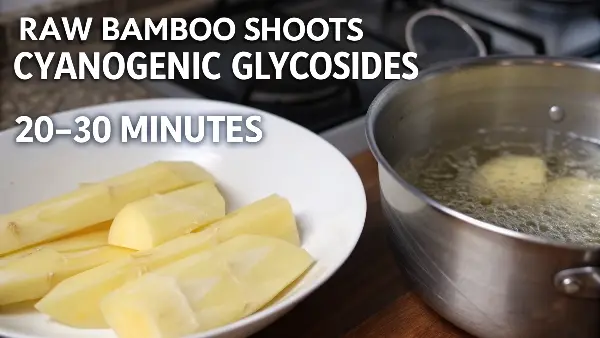
This sounds much scarier than it is. Many common foods we eat contain similar compounds, including lima beans, almonds, and the pits of stone fruits like apricots and cherries. We’ve simply learned through generations of cooking knowledge how to prepare them safely. I see it as a sign of respect for the ingredient. Taking the time to properly prepare a fresh bamboo shoot connects us to a long history of culinary wisdom. The process isn’t just for safety; it also removes bitterness and creates the tender texture we love. It transforms the shoot from its raw, defensive state into a welcoming food.
The Science Made Simple
Understanding the "why" makes the "how" feel less like a chore and more like smart cooking.
-
What Are Cyanogenic Glycosides?
Think of these as a two-part defense system locked away in the plant’s cells. One part is the glycoside itself (in bamboo, it’s called taxiphyllin), and the other is an enzyme. They are stored separately. When an animal chews the raw plant, the cells are broken, the two parts mix, and the toxic compound (hydrogen cyanide) is released. This discourages the animal from eating more. It’s a brilliant evolutionary trick.
-
How Cooking Saves the Day
Heat, especially from boiling water, completely deactivates the enzyme. Without the enzyme, the reaction can’t happen, and the cyanide is never released. The heat also helps the taxiphyllin itself break down and leach out into the cooking water. This is why you should always discard the water you used to boil the shoots. It’s a simple, foolproof chemical process that happens in your own kitchen.
Fresh vs. Canned: What You Need to Know
This distinction is crucial for safety and convenience.
-
Fresh Bamboo Shoots
These are the ones you harvest yourself or buy from a farmer’s market. They always, without exception, need to be peeled and boiled before being used in any recipe. This is the non-negotiable step. After boiling, they can be stir-fried, pickled, or added to soups.
-
Canned or Vacuum-Packed Bamboo Shoots
These products, which are what most people have access to, have already been processed for you. The shoots are peeled, sliced, boiled, and canned in a brine or water. They are completely safe to eat straight from the can. All you need to do is drain them and rinse if you prefer. This is a fantastic, convenient way to enjoy bamboo without any of the prep work.
So, never eat bamboo shoots raw. But don’t let that scare you. Just see boiling as the first, essential step in any recipe that uses fresh shoots.
How Do You Harvest and Prepare Bamboo Shoots for Your Kitchen?
So, you have access to fresh bamboo shoots, maybe from your own garden or a generous neighbor. But they’re covered in tough, pointy leaves and feel hard as a rock. You’re worried that hacking away at it will leave you with nothing but scraps, wasting the potential meal. I’ll walk you through the simple, traditional method to get from a muddy shoot to a kitchen-ready ingredient.
First, harvest shoots when they are young and tender, ideally under one foot tall. Use a shovel to cut the shoot just below the soil line. To prepare it, slice off the very hard bottom section. Then, make a score down one side and peel away the tough outer sheaths until you reach the pale, tender core. Finally, boil this core in water for at least 20-30 minutes to ensure it’s safe and tender.
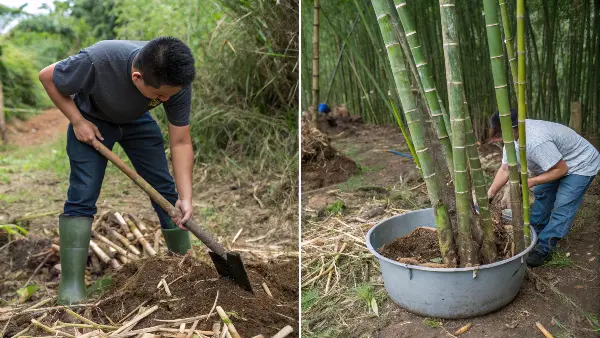
The first time I prepared a fresh shoot, I was surprised by how much you discard. It felt wasteful until I realized that the outer sheaths are like a natural armor. Their job is to protect the delicate heart inside. The process is a bit like preparing an artichoke; you peel away the tough exterior to get to the delicious prize within. There’s something deeply satisfying about it. With a little practice, you can break down a shoot in just a couple of minutes. It feels like unlocking a secret.
From the Ground to the Pot: A Step-by-Step Guide
Follow these steps for perfect results every time.
-
Step 1: The Harvest
The best time to harvest is in the morning when the shoots are full of moisture. Look for shoots that are just emerging from the ground. Use a sturdy shovel or a sharp knife to sever the shoot from its underground rhizome. The younger and smaller the shoot, the more tender it will be.
-
Step 2: The Initial Trim and Peel
Once you have your shoots, wash off any dirt. Using a sharp knife, slice off the bottom part of the shoot, which is very hard and fibrous. Then, stand the shoot upright and make a deep slice from top to bottom, cutting through the outer sheaths but not deep into the core. This makes peeling much easier. From there, you can unwrap the tough layers with your hands, just like peeling an onion. Keep going until you are left with a pale, solid cone of tender bamboo.
-
Step 3: The Detoxifying Boil
This is the most critical step. Place the peeled shoots in a large pot of water and bring it to a boil. Let them cook at a rolling boil for at least 20-30 minutes, or until a fork can be easily inserted. Some traditional recipes suggest adding a handful of rice bran or a few hot peppers to the water to help draw out bitterness, but plain water works perfectly fine. Once cooked, drain the shoots and discard the water.
-
Step 4: Final Prep and Storage
Let the boiled shoots cool. Now they are a ready-to-use ingredient. You can slice them, dice them, or shred them for your recipes. If you’ve prepared a large batch, you can store the cooked shoots in a container of fresh water in the refrigerator for up to a week. Just be sure to change the water daily. They can also be frozen for long-term storage.
What Are the Health Benefits and Sustainable Advantages of Eating Bamboo?
You want to make food choices that are good for your body but also good for the planet. It can feel like a compromise, where healthy options have a high environmental cost or sustainable foods lack nutritional punch. This is where bamboo truly stands out. It’s a rare example of a food that excels in both categories without any trade-offs.
Bamboo shoots are a low-calorie, high-fiber food packed with potassium, manganese, and essential vitamins, supporting digestive health and heart function. Environmentally, bamboo is a sustainability champion. It’s one of the fastest-growing plants on earth, requires no pesticides or fertilizers, regenerates after harvesting, prevents soil erosion, and captures huge amounts of CO2. Eating bamboo is truly a win-win for personal and planetary health.
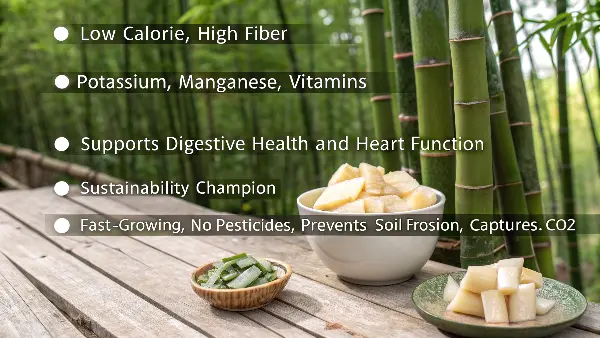
At Ecosourcecn, our entire mission is built on the power of sustainable materials, and bamboo is a cornerstone of that vision. The very same qualities that make it an amazing, renewable resource for our compostable cutlery and containers also make it an incredible food source. Its rapid growth and resilience mean we can harvest it without depleting natural forests. When I see a client switch from plastic to bamboo packaging, I feel the same satisfaction as when I cook a meal with fresh bamboo shoots. It’s a practical, positive choice for a greener future.
Good for You: The Nutritional Profile
Bamboo shoots are more than just a crunchy addition to a stir-fry; they are a nutritional powerhouse.
-
A Low-Calorie, High-Fiber Wonder
A cup of cooked bamboo shoots contains very few calories but is loaded with dietary fiber. This makes you feel full and satisfied, which can aid in weight management. The high fiber content is also excellent for digestive health, promoting regularity and a healthy gut microbiome.
-
Rich in Vitamins and Minerals
Bamboo shoots provide a good source of potassium, which is vital for regulating blood pressure and heart health. They also contain manganese, a crucial mineral for bone health and metabolism, along with various B vitamins that help your body convert food into energy.
Good for the Planet: The Sustainability Angle
The environmental case for bamboo is just as strong as the nutritional one.
-
Rapid Renewability
Bamboo is technically a grass, not a tree. Some species can grow up to three feet in a single day. This incredible growth rate means it can be harvested annually without harming the plant or the ecosystem. The root system, called a rhizome, remains in the ground and will send up new shoots the following year.
-
A Low-Impact Crop
Bamboo thrives without the need for agricultural chemicals. It naturally resists pests and doesn’t require fertilizers to grow quickly. It also requires very little water, especially compared to other crops.
-
A Climate Change Fighter
A mature bamboo grove releases 35% more oxygen than a similar-sized stand of hardwood trees and can sequester massive amounts of carbon dioxide. Its dense root system is also fantastic for preventing soil erosion and helping to restore degraded land. By choosing bamboo, both for food and for products, you support a farming system that helps heal the planet.
Conclusion
From a mysterious plant to a kitchen staple, bamboo offers a journey into sustainable and healthy eating. By learning to identify the right species, prepare them safely through boiling, and understanding their incredible benefits, you can confidently add this amazing vegetable to your diet. It’s a choice that nourishes you and supports our planet’s health.


